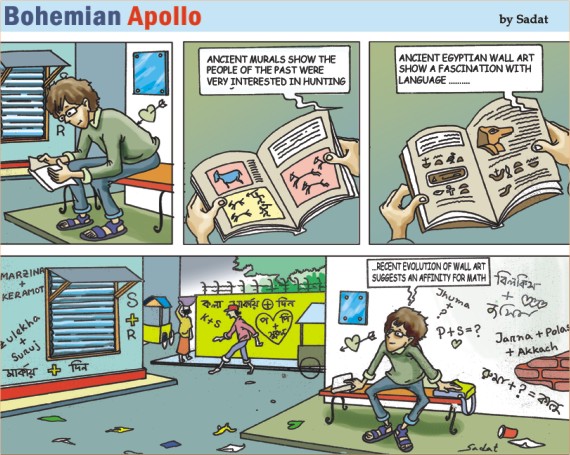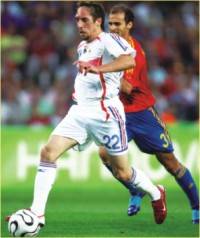

Sci-stuff: The earth is flat
As countless photos from space can attest, Earth is roundthe "Blue Marble," as astronauts have affectionately dubbed it. Appearances, however, can be deceiving. Planet Earth is not, in fact, perfectly round.
This is not to say Earth is flat. Well before Columbus sailed the ocean blue, Aristotle and other ancient Greek scholars proposed that Earth was round. This was based on a number of observations, such as the fact that departing ships not only appeared smaller as they sailed away but also seemed to sink into the horizon, as one might expect if sailing across a ball.
Isaac Newton first proposed that Earth was not perfectly round. Instead, he suggested it was an oblate spheroida sphere that is squashed at its poles and swollen at the equator. He was correct and, because of this bulge, the distance from Earth's center to sea level is roughly 21 kilometers (13 miles) greater at the equator than at the poles.
Our globe, however, is not even a perfect oblate spheroid, because mass is distributed unevenly within the planet. The greater a concentration of mass is, the stronger its gravitational pull, "creating bumps around the globe," says geologist Joe Meert at the University of Florida in Gainesville.
Earth's shape also changes over time due to a menagerie of other dynamic factors. Mass shifts around inside the planet, altering those gravitational anomalies. Mountains and valleys emerge and disappear due to plate tectonics. Occasionally meteors crater the surface. And the gravitational pull of the moon and sun not only cause ocean and atmospheric tides but earth tides as well.
There's also postglacial rebound, with the crust and mantle that were depressed by the huge ice sheets that sat on the surface during the last ice age now rebounding upward on the order of a centimeter a year.
Also, to even out Earth's imbalanced distribution of mass and stabilize its spin, the entire surface of the Earth will rotate and try to redistribute mass along the equator, a process called true polar wander, says Meert.
To keep track of Earth's shape, scientists now position thousands of Global Positioning System receivers on the ground that can detect changes in their elevation of a few millimeters. Another method, dubbed satellite laser ranging, fires visible-wavelength lasers from a few dozen ground stations at satellites. Any changes detected in their orbits correspond to gravitational anomalies and thus mass distributions inside the planet. Still another technique, very long baseline interferometry, has radio telescopes on the ground listen to extragalactic radio waves to detect changes in the positions of the ground stations. It may not take much technology to understand that Earth is not perfectly round, but it takes quite a bit of effort and equipment to determine its true shape.

By Quazi Zulquarnain Islam
Prologue
If there was a turning point in the 2006 World Cup for France, it had to be the image of the diminutive number 22 racing through the Spanish backline before firing past Iker Casillas to haul Les Blues back into a game they looked like losing.
The rest as they say was history.
It completed a fairytale for the player in question, but then again in football a lot of fairytales are spun there are rags to riches story galore.
What makes Franck Ribery's story just that bit different, is because it could very well almost not have been.
Early Horror
Why you ask?
At the age of two, little Franck was in a horrible car accident that catapulted him through the windshield of the vehicle onto the tarmac more than a dozen feet away. The sight was grisly and with all the blood everyone was sure that Franck had passed away.
But showing the grit and determination that marked him out in later years, Ribery bounced back although he still bears the horrendous scars of that accident on his face a physical attribute that has won him the nickname of “Scarface.”
But even aside the horrendous accident that could have nearly claimed his life, Ribery had no question being in the France team for the 2006 World Cup.
Adolescence
Born into the notorious Chemin-Verte estate on the edge of Boulogne, Ribery grew up a difficult child, constantly skiving school and kicking a ball around in the dilapidated row of flats. It was there that he met his future wife Wahiba, who made him convert to Islam.
Ribery's life looked to be on a downward spiral but Lille saved him by offering him a spot in their academy. It was a ticket out of his dead-end life but Ribery spoilt that thrown out of the academy for not trying in classes and getting into too many fights.
Luckily he got picked up by the Boulogne U-17 sides and by 2003 had managed to work his way upto the Third Division, turning out regularly for club side Ales.
Worse was to follow though as Ales became bankrupt and the end of his career beckoned.
But Brest, a club in the same division noticed and whisked him away. It was only three years until the World Cup and Ribery was light years away from even imagining that he would be involved.
Turning Point
But that season would prove to be a turning point.
In a script that could be right out of Hollywood, Ribery's blistering pace and burgeoning assists caught the eye of respected coach Jean Fernandez, then at Metz. Several times the coach drove right across the country from east to west to watch Ribery play. He ended up getting his man.
 21 when he signed with Metz, Ribery instantly drew comparisons with the club's favourite son, Robert Pires. He set the Ligue 1 alight in his first few months coping with the jump in divisions easily.
21 when he signed with Metz, Ribery instantly drew comparisons with the club's favourite son, Robert Pires. He set the Ligue 1 alight in his first few months coping with the jump in divisions easily.
Impetuosity
But his impetuous side shone through and he quit Metz after only half a season to turn out for Turkish champions Galatasaray.
Six months on, there was more stunning news as the crowd favourite at Turkey announced he was quitting the club to move to Marseille and be reunited with Fernandez. The Frenchman who was nicknamed “Ferra-ribery” during his time their cited non-payment of wages and there was even a bizarre public spat with an agent who turned up on his doorstep with a baseball bat to settle a few differences!!
True Calling
At Marseille, Ribery found his true calling, excited at the prospect of turning out at the Stade Velodrome where his idols Chris Waddle and Jean Pierre Papin had once strutted their stuff.
And ofcourse there was Fernandez a man he regards his spiritual father.
Ribery's dazzling ball skills, mazy dribbles and sheer grit, determination and will to win won over the notoriously demanding supporters and there was soon a campaign for him to be included in the national setup.
The Climax
Domenech resisted and resisted until finally giving him, picking the youngster ahead of established names like Nicolas Anelka, Johan Micoud and Ludovic Giuly.
Despite some early problems Ribery settled in brilliantly and his transition culminated in the goal against Spain that set France on their way to their run to the final.
Aftermath
After another sparkling season at Marseille where Ribery helped them to second in the league, he has since moved on to Bayern Munich for a transfer fee of 25 million Euros.
